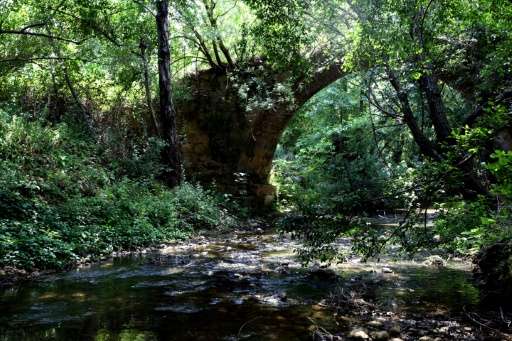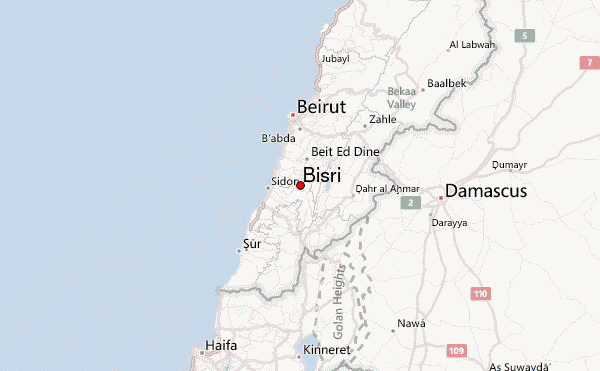
by Rouba El Husseini
Lebanon’s government says a dam planned for a valley near Beirut is vital to tackle chronic water shortages, but the location on a seismic fault line has raised fears among residents.
“How can you build a dam in an earthquake zone? We don’t even have houses that are earthquake-proof,” said Amer Meshmushi, a resident of Bisri Valley, 35 kilometres (20 miles) south of Beirut.
He grew up hearing about the last major earthquake on the Roum fault, in 1956, which killed 135 people and damaged thousands of houses including his family home in Basaba village.
“My brother was still little, and they had to drag him out from under the rubble,” the 50-year-old recalled his parents telling him as a child.
Lebanon’s government and the World Bank say the Bisri dam is desperately needed to address water shortages afflicting greater Beirut’s 1.6 million residents.
They insist the structure will be safe and say measures will be taken to mitigate seismic risks.
But Meshmushi’s concerns are shared by local activists, including Raja Noujaim, head of the Association for the Protection of the Lebanese Heritage.
“When we look at the region’s history and geography, we see that all of its valleys are the result of the fact that it is a seismic zone,” he told AFP.
Activists say an earthquake could cause the dam to burst and that the structure and its reservoir would put pressure on the fault line and increase seismic activity.
‘Wiping out farmers’
The World Bank and Lebanon’s Council for Development and Reconstruction (CDR), a government agency that supervises major infrastructure projects, identified the valley as a prime location for a dam thanks to its abundant water, wide basin and proximity to Beirut.
In a report, the World Bank said a panel of four “internationally recognised experts” recruited by the CDR had reviewed safety studies, adding that the dam’s design was “consistent with international best practice”.
The World Bank told AFP that tests showed the dam had “a resistance to shocks above the one provoked by the 1956 earthquake,” which measured a six on the Richter scale—similar to the strength of the quakes that devastated central Italy last year.

Eli Mussali, the CDR engineer overseeing the project, said the dam could “withstand earthquakes up to eight on the Richter scale, which is a very high degree.”
He also downplayed the possibility that the structure could provoke seismic activity, saying there was no evidence for such a phenomenon.
And he noted the country’s largest dam, in the eastern region of Qaraoun, is situated atop the major Yammouneh fault line.
“It is geologically normal for faults to run between mountains, where rivers run and dams are built,” he said.
At present, Lebanon stores just six percent of its water in reservoirs. Many people rely on illegally drilled wells that are increasingly over-exploited and produce water of dubious quality.
Construction of the Bisri dam is expected to begin later this year with a $617-million (544-million-euro) price tag, mostly covered by a World Bank loan.
It will take nine years to finish and will be the country’s second-largest dam, with a capacity of 125 million cubic metres (4.4 billion cubic feet) in a reservoir covering 450 hectares (1,100 acres).
Land belonging to 15 villages will be gobbled up by the facility, including Meshmushi’s fields.
“Does it serve Beirut’s interests to wipe out farmers?” he asked.
“These lands are the source of our livelihoods. They allowed me and my brother to get an education.”
‘Where will we go?’
Bisri Valley is covered in a patchwork of farms growing everything from lemons and pine trees to strawberries and pomegranates, mostly tended by seasonally hired Lebanese labourers and Syrian refugees.
The CDR plan includes a fund to compensate owners of the 869 plots of land that will be expropriated, but it remains unclear if the farmers will also be compensated for losing their jobs.
Fifty-year-old Abu Salem has farmed beans in the village of Marj Bisri for 25 years.
“I’m a farmer, not a civil servant. I don’t have anywhere else to go,” he said, sitting on a tractor.
“I taught my children how to farm. If we leave here, where will we go?”
Locals also fear for archeological sites that will disappear under the water.
They include the Mar Musa church in Marj Bisri, a tiny stone edifice locals say is hundreds of years old and has become a shrine for residents of all faiths.
Authorities proposed to dismantle the church and rebuild it elsewhere, but villagers rejected the offer.
Further downstream are five columns, four standing and one toppled, that are believed to be Roman and could be evidence of a larger archaeological site.
That area will one day be at the bottom of the reservoir.
The CDR’s Mussali said there are plans for the Antiquities Department to excavate the site and decide if it is worth saving.
But residents say the dam project should be scrapped entirely.
“We shouldn’t be thinking about building anything in the area, whether a dam or anything else,” said Noujaim. “It’s dangerous. This project mustn’t be done.”
PHYS.ORG



Leave a Reply
You must be logged in to post a comment.